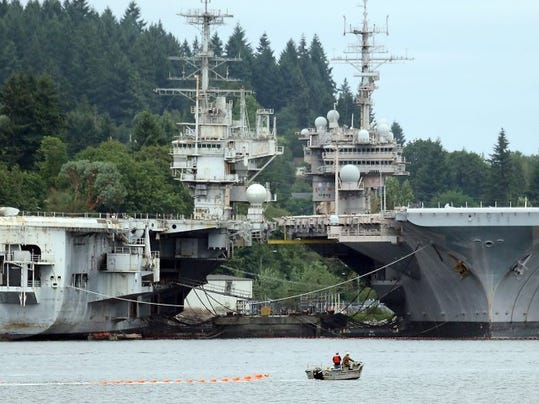
The fate of the former USS Kitty Hawk — a part of Bremerton's iconic waterfront of mothballed ships for more than eight years — has been determined.
The Kitty Hawk (CV 63) will be disposed of by
dismantling, according to Naval Sea Systems Command spokeswoman Colleen
O'Rourke.
O'Rourke cited an annual report to Congress
that outlines the Navy's five-year shipbuilding plans. In this fiscal year's
edition, released in April 2016, the Kitty Hawk was listed as one of the Navy's
inactive ships slated for scrapping.
The Navy has not yet determined when the
Kitty Hawk will depart its berthing in Bremerton, where the ship will go to be
dismantled or what company will be awarded the contract, O'Rourke said.
Previous aircraft carriers berthed at Puget
Sound Naval Shipyard, including the USS Independence (CV 62), USS Ranger (CV
61) and USS Constellation (CV 64) were sent to Brownsville, Texas, for
scrapping.
The Kitty Hawk was decommissioned at PSNS in
2009 after 48 years of active service. The ship has been held in reserve status
at the Inactive Ship Maintenance Facility in Bremerton ever since.
During the ship's active service, the Kitty
Hawk participated in combat operations in Southeast Asia during the Vietnam War
and in the Arabian Sea during Operation Enduring Freedom and Operation Iraqi
Freedom. The Kitty Hawk was the fleet's only permanently forward-deployed
carrier in Yokosuka, Japan, from 1998 to 2008.
The Kitty Hawk was the last conventionally
powered aircraft carrier in active service in the fleet. There are currently 10
nuclear-powered Nimitz-class carriers and one Ford-class carrier in active
service, with construction on two more Ford-class carriers in progress.
Then-Secretary of the Navy Donald Winter sent
a letter to Congress in 2008 expressing his intent to hold the Kitty Hawk in
reserve status until the USS Gerald R. Ford's commissioning, O'Rourke said. The
Ford (CVN 78), the first and namesake of the newest class of nuclear-powered
aircraft carriers, was commissioned on July 22. The Naval Vessel Register
currently lists the Kitty Hawk as out of commission, in reserve, but it has not
been updated since September 2015, two years before the Ford's commissioning.
Over the years, speculation on the Kitty
Hawk's fate has ranged from recommissioning the ship back into active service
to turning the ship into a museum.
The Navy's 2016 force structure assessment
called for increasing the active service fleet size from between 270 to 290
ships up to 355 ships, including increasing the number of active service
aircraft carriers from 11 to 12.
Although the Navy had once considered the
possibility of recommissioning the Kitty Hawk to increase the size of the
fleet, Secretary of the Navy Richard Spencer said that would be cost
prohibitive in a recent interview with the Kitsap Sun.
"The business case for the Kitty Hawk
would be a fairly big stretch," Spencer said.
O'Rourke said the Kitty Hawk was not selected
for possible museum donation and the Navy will not be accepting applications
for such a donation, despite numerous groups who have expressed interest in
preserving the ship as a museum.
The USS John F. Kennedy (CV 67), a variation
of the Kitty Hawk-class carriers, was the last conventionally powered aircraft
carrier built. It was decommissioned in 2007 and is currently berthed at the
Inactive Ship Maintenance Facility in Philadelphia. Unlike the Kitty Hawk, the
carrier is currently eligible for donation as a museum.
Source:
kitsapsun.
24 October 2017
No comments:
Post a Comment